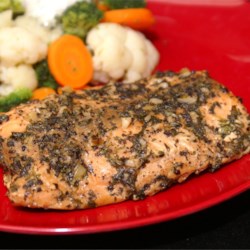This dish is so delicious.
Have you ever tried to roast a chicken, only for it to turn out dry and disappointing?... No? Just me? Ok, well, even so, this chicken really has no choice but to stay moist with all the juices involved. And the veggies that go with it?? YUM.
Mary and Sara recommend spicing things up a bit if you end up using this recipe a lot, by using a rub or a glaze. Their suggestions: "experiment by rubbing the bird with jerk or Cajun seasoning, a cumin and coriander spice mixture, or coarse lavender salt (there are so many great spice rubs out in the marketplace to try). Brushing with a mixture of warm honey, rosemary, and cayenne is over the top (I tried this one, but definitely keep a close eye on it, because the glaze will burn), and basting with bacon grease and maple syrup is sweet home Carolina (tent with foil midway through roasting if using sweet glazes, to avoid burning)."
Roast Chicken and Vegetables for Two
(Original recipe by Mary Corpening Barber and Sara Corpening Whiteford)
Ingredients
- 3 carrots, cut into thirds
- 6 small red mew potatoes, quartered if large
- 1 medium yellow onion, cut into 6 wedges
- 3 tablespoons unsalted butter, melted, or olive oil
- Kosher salt and freshly ground pepper
- 1 chicken (3 to 4 pounds)
- 1 lemon, quartered
- 2 fresh rosemary sprigs
- 4 cloves garlic, peeled and smashed
Preheat the oven to 425 degrees F.
Put the carrots, potatoes, and onion in a 9-by-13-inch glass baking dish. Toss the vegetables with 1 tablespoon of butter. Season with kosher salt and pepper to taste. Spread the vegetables to the edges of the baking dish, making room for the chicken.
Remove the neck and giblets from the cavity of the chicken and discard. Rinse the bird under cold running water and pat dry. Put the chicken, breast-side up, in the center of the baking dish. Brush the chicken with the remaining 2 tablespoons butter. Season the cavity and skin generously with kosher salt and pepper to taste. Put the lemon quarters and rosemary sprigs inside the cavity. Put the garlic cloves under the chicken to prevent them from burning.
Roast for 45 minutes. Remove the dish from the oven. Using tongs, tilt the chicken, pouring the juices from the cavity onto the vegetables, and shake to coat. Baste the chicken with the pan juices. If the bird is browning too quickly, cover with aluminum foil. Continue roasting until the chicken is a deep golden brown and the juices run clear when the tip of a knife is inserted into the thigh joint, or until an instant-read thermometer inserted into the thigh, away from the bone, registers 170 to 175 degrees F, 25 to 30 minutes more.
Transfer the chicken to a platter, cover loosely with aluminum foil, and let stand for 10 to 15 minutes before carving. Using the back or a spoon, mash the garlic and squeeze some lemon into the pan juices. Toss the juices with the vegetables. Carve the chicken* and serve the vegetables alongside. Drizzle any remaining juices over the chicken.
Note: Our favorite way to serve roasted chicken to our families is to carve all the meat from the bones after the meat has rested and chop it into bite-sized pieces. We then return the meat to the garlicky, lemony pan juices, re-season it with more salt and pepper, and toss with the vegetables. This way, every last bit of chicken is well seasoned and moist throughout (breasts included).
*Carving a Chicken or Turkey
- Anchor the breast of the bird with a carving fork and, using a boning or carving knife, cut through the skin between the thigh and the breast. Pull the leg and second joint outward. This exposes the joint at the bottom of the thigh, which is easily cut through.
- Detach the leg and cut the thigh away from the drumstick. Turn the bird around and repeat with the other leg.
- If serving the wings separately, pull the wing out from the breast and cut through the joint that connects with wing to the breast. Repeat with the other wing.
- For chicken, you may opt to serve the breasts whole. To do this, cut between the meat and the bone, angling the knife toward the bone. Otherwise, cut thin slices of the breast meat on a diagonal to the breastbone, including a little skin with each slice.








